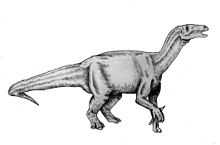Lurdusaurus
| Lurdusaurus Temporal range: Early Cretaceous, 112Ma | |
|---|---|
 | |
| Forelimb, Royal Belgian Institute of Natural Sciences | |
| Scientific classification | |
| Kingdom: | Animalia |
| Phylum: | Chordata |
| Clade: | Dinosauria |
| Order: | †Ornithischia |
| Clade: | †Ornithopoda |
| Clade: | †Styracosterna |
| Clade: | †Hadrosauriformes |
| Genus: | †Lurdusaurus Taquet & Russell, 1999 |
| Species: | † L. arenatus |
| Binomial name | |
| Lurdusaurus arenatus Taquet & Russell, 1999 | |
Lurdusaurus (name meaning 'weighty lizard') is a genus of large ornithopod dinosaur which lived in the Aptian stage of the Early Cretaceous, sometime between 121 to 112 million years ago.
Discovery and naming
In 1965 Philippe Taquet discovered the partial remains of a euornithopod in the Tenere in Niger. In 1988 Souad Chabli coined the name "Gravisaurus tenerensis" in her dissertation on the animal.[1] Such a nomen ex dissertatione, however, remains an invalid name if not published together with a description. As Chabli had left the field of paleontology, the type species Lurdusaurus arenatus was formally named by Taquet and Dale Russell in 1999. The generic name is derived from Latin lurdus, "heavy", with the same meaning as the original gravis. The specific name arenatus means "sandy", like "tenerensis" a reference to the Tenere desert.[2]
The holotype MNHN GDF 1700 was found in layers of the Elrhaz Formation dating to the upper Aptian-lower Albian. It consists of a partial skeleton with a fragmentary skull.
Description
Unusual build

Lurdusaurus was enormously heavily built. Taquet originally estimated a length of 30 ft (9m), 40% shorter than Spinosaurus, the longest carnivorous dinosaur known to date, but probably with around the same mass, i.c 5.5 tonnes. In 2010 however, Gregory S. Paul gave a lower estimate of seven metres and 2.5 tonnes.[3] Due to a short lower leg, its torso was characteristically low-slung, with the abdomen as little as 2.4 ft (0.71m) above ground level, and the rib cage was extremely broad. Its neck was relatively longer (5.3 ft [1.6m]) and its tail relatively shorter than that of other euornithopods. Even more so than with other large basal iguanodonts, the forelimbs were extremely powerful, with the innermost digit of each hand consisting of little more than a very large conical claw, presumably used for defense. The broad shortened hand was adapted to carrying the weight of the animal. The foot was unusually constructed in that the foot bones (metatarsals) lacked solid contact with each other, as in animals that can widely splay the toes, and this arrangement also indicates the presence of a single foot pad, precluding any ability to run quickly.
Its overall body plan was therefore very unusual compared to other ornithopods, and its describers Taquet and Russell suggested that it would have looked superficially like an ankylosaur.[2] Paleontologist Tom Holtz has suggested that, based on its overall stocky build, short limbs and splaying toes, it may have been led an aquatic or semi-aquatic, hippopotamus-like lifestyle.[4]
Paleobiology
Defense

Due to its hefty and apparently ungainly build, Lurdusaurus was most likely a slow-moving animal, not built for speed and therefore probably not capable of fast retreats from predators. However, its low-slung torso, while prohibiting it from running at high speeds, would have given it a low centre of gravity, allowing it to suddenly wheel round to face an attacker. Its thumb claws would have been formidable weapons, able to inflict possibly fatal damage to a predator if a blow was delivered to the neck or flank.
Contemporaneous dinosaurs
Lurdusaurus was contemporaneous with the bizarre large theropod Suchomimus, which some believe to be synonymous with the slightly earlier Baryonyx from England, and with the sympatric Ouranosaurus, notable for its tall-spined vertebrae. The remains of the allosauroid theropod Eocarcharia and the abelisauroid Kryptops have also been found in the Aptian of Niger.
Notes
- ↑ Chabli, S., 1988, Étude anatomique et systématique de Gravisaurus tenerensis n. g., n. sp. (Dinosaurien, Ornithischien) du gisement de Gadoufauoua (Aptien du Niger). Ph.D. dissertation, Université de Paris VII. UFR de Biologie et des Sciences de la nature 164 pp
- ↑ 2.0 2.1 P. Taquet and D. A. Russell, 1999, "A massively-constructed iguanodont from Gadoufaoua, Lower Cretaceous of Niger", Annales de Paléontologie 85(1): 85-96
- ↑ Paul, G.S., 2010, The Princeton Field Guide to Dinosaurs, Princeton University Press p. 288
- ↑ Holtz, Thomas R. Jr. (2011) Dinosaurs: The Most Complete, Up-to-Date Encyclopedia for Dinosaur Lovers of All Ages, Winter 2010 Appendix.